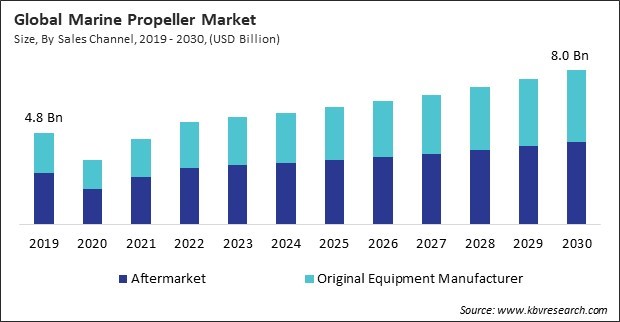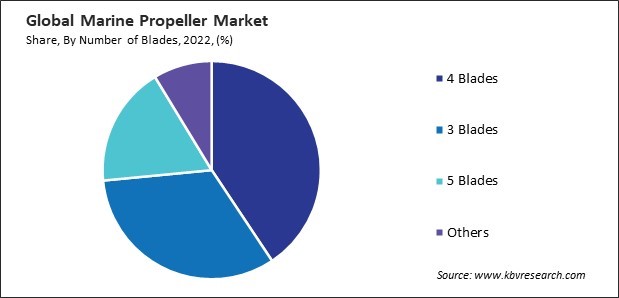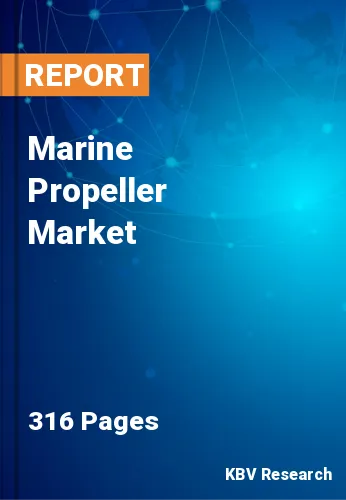“Global Marine Propeller Market to reach a market value of USD 8 Billion by 2030 growing at a CAGR of 5.3%”
The Global Marine Propeller Market size is expected to reach $8 billion by 2030, rising at a market growth of 5.3% CAGR during the forecast period.
The expansion of naval fleets globally, driven by geopolitical developments and the need for maritime security, directly increases the demand for advanced marine propellers. Consequently, the naval ships segment would generate approximately 25.64% share of the market by 2030. Naval operations often require precise maneuverability, rapid changes in speed, and the ability to navigate confined spaces. Modern naval strategies emphasize stealth capabilities and reduced acoustic signatures to enhance the survivability of naval vessels.

Global demand for seafood has led to increased fishing activities, necessitating a larger fleet of fishing vessels. The growth of aquaculture, including fish farming and shellfish cultivation, requires specialized support vessels for activities such as feeding, maintenance, and harvesting. Vessels dedicated to aquaculture support, such as workboats and service vessels, rely on efficient marine propellers to navigate aquaculture facilities and perform various tasks. Therefore, the market is expanding significantly due to the increased fishing and aquaculture activities. Moreover, Offshore drilling operations require a fleet of support vessels for transportation, supply, and crew transfer tasks. Support vessels involved in offshore drilling operations, including platform supply vessels (PSVs) and anchor handling tug supply vessels (AHTS), rely on advanced marine propellers for precise maneuvering and efficient propulsion. Thus, the increase in offshore maintenance activities contributes to the growth of the market.
However, High initial costs for upgrading or retrofitting vessels with modern marine propellers may exceed the budgets of some shipowners. Vessel owners may delay or forego investments in new propulsion systems due to financial constraints, limiting the market's immediate growth potential. Limited access to financing options for vessel upgrades can hinder shipowners' ability to invest in new propulsion systems. Therefore, high initial costs are a significant challenge that hampers the growth of market.
Based on sales channel, the market is bifurcated into original equipment manufacturer and aftermarket. In 2022, the aftermarket segment led the market by generating highest revenue share. Aftermarket services, such as maintenance and repair, extend the operational lifespan of marine propellers. Aftermarket solutions may include upgrades and performance enhancements, allowing boat owners to enhance the capabilities of their propulsion systems. Aftermarket services include the availability of spare parts, ensuring that boat owners can easily replace components to maintain or restore propeller functionality. Aftermarket solutions adapt to technological advancements, allowing boat owners to retrofit their vessels with the latest propulsion technologies.
Based on material, the market is classified into aluminum, stainless steel, and others. The aluminum segment acquired a substantial revenue share in the market in 2022. Aluminum propellers are lightweight compared to propellers made from other materials, such as stainless steel or bronze. The lightweight nature of aluminum propellers contributes to improved vessel performance, particularly acceleration and fuel efficiency. This advantage is valuable for marine applications, including recreational boating and smaller commercial vessels. The flexibility of aluminum allows the propeller to deform upon impact, reducing the risk of catastrophic failure. This is especially beneficial in applications where the propeller may encounter underwater obstacles or debris. It enhances the durability and safety of the propeller, making it suitable for various operating conditions.
On the basis of number of blades, the market is divided into 3 blades, 4 blades, 5 blades, and others. In 2022, the 4 blades segment dominated the market with maximum revenue share. 4-blade propellers improve control and maneuverability, allowing vessels to navigate more precisely. The enhanced maneuverability is valuable in maritime scenarios, including docking, tight turns, and intricate navigation. Vessels requiring precise control, such as ferries, tugboats, and certain recreational boats, find 4-blade propellers advantageous, driving their adoption and market segment growth.

By type, the market is categorized into fixed pitch propeller (FPP), controllable pitch propeller (CPP), and others. The controllable pitch propeller (CPP) segment covered a considerable revenue share in the market in 2022. CPPs are particularly advantageous in situations that demand precise maneuvering, such as docking, navigating through narrow channels, or performing complex offshore operations. This enhanced maneuverability contributes to the expanded use of CPPs in diverse maritime applications. The emphasis on minimizing the environmental impact of vessel operations, including reducing underwater noise pollution, has led to the increased use of CPPs. This benefit is particularly significant in applications where noise reduction is a priority, such as research vessels and marine life observation platforms.
By application, the market is segmented into merchant ships, naval ships, recreational boats, and others. In 2022, the merchant ships segment registered the maximum revenue share in the market. Marine propellers are designed to provide optimized performance, ensuring efficient propulsion and maneuverability of merchant ships. Marine propellers are constructed to be reliable and durable, minimizing the risk of breakdowns and ensuring operational continuity. Well-designed marine propellers provide operational flexibility, allowing merchant ships to navigate various sea conditions and adapt to different operational requirements. Well-engineered marine propellers enhance the safety of merchant ships by providing precise control and maneuverability.
Free Valuable Insights: Global Marine Propeller Market size to reach USD 8 Billion by 2030
Region-wise, the market is analysed across North America, Europe, Asia Pacific, and LAMEA. In 2022, the Asia Pacific region acquired a significant revenue share in the market. Asia Pacific is home to a diverse and expanding fishing industry. The popularity of recreational boating is rising in Asia Pacific, driven by increasing disposable incomes and a growing middle class. Naval forces in the Asia Pacific are undergoing modernization efforts to strengthen maritime security capabilities. Asia Pacific is witnessing advancements in marine propulsion technologies, including developing more efficient and environmentally friendly propulsion systems.
| Report Attribute | Details |
|---|---|
| Market size value in 2022 | USD 5.4 Billion |
| Market size forecast in 2030 | USD 8 Billion |
| Base Year | 2022 |
| Historical Period | 2019 to 2021 |
| Forecast Period | 2023 to 2030 |
| Revenue Growth Rate | CAGR of 5.3% from 2023 to 2030 |
| Number of Pages | 316 |
| Number of Tables | 540 |
| Report coverage | Market Trends, Revenue Estimation and Forecast, Segmentation Analysis, Regional and Country Breakdown, Porter’s 5 Forces Analysis, Company Profiling, Companies Strategic Developments, SWOT Analysis, Winning Imperatives |
| Segments covered | Sales Channel, Material, Number of Blades, Type, Application, Region |
| Country scope |
|
| Companies Included | Volvo Group, Brunswick Corporation, Kawasaki Heavy Industries, Ltd., Hyundai Heavy Industries Co., Ltd., MAN Energy Solutions SE (Volswagen Group), Nakashima Propeller Co., Ltd. (Nakashima Holdings Co., Ltd., Rolls-Royce Plc (Rolls-Royce Holdings Plc), Schottel GmbH (Schottel Industrial GmbH), VEEM Ltd., Wartsila Corporation |
By Sales Channel
By Material
By Number of Blades
By Type
By Application
By Geography
This Market size is expected to reach $8 billion by 2030.
Increased fishing and aquaculture activities are driving the Market in coming years, however, High initial costs of marine propellers restraints the growth of the Market.
Volvo Group, Brunswick Corporation, Kawasaki Heavy Industries, Ltd., Hyundai Heavy Industries Co., Ltd., MAN Energy Solutions SE (Volswagen Group), Nakashima Propeller Co., Ltd. (Nakashima Holdings Co., Ltd., Rolls-Royce Plc (Rolls-Royce Holdings Plc), Schottel GmbH (Schottel Industrial GmbH), VEEM Ltd., Wartsila Corporation
The expected CAGR of this Market is 5.3% from 2023 to 2030.
The Fixed Pitch Propeller (FPP) segment is leading the Market by Type in 2022 there by, achieving a market value of $4 Billion by 2030.
The Europe region dominated the Market by Region in 2022 there by, achieving a market value of $3 Billion by 2030, growing at a CAGR of 4.8 % during the forecast period.
Our team of dedicated experts can provide you with attractive expansion opportunities for your business.

 Drivers
Drivers
 Restraints
Restraints
 Opportunities
Opportunities
 Challenges
Challenges
